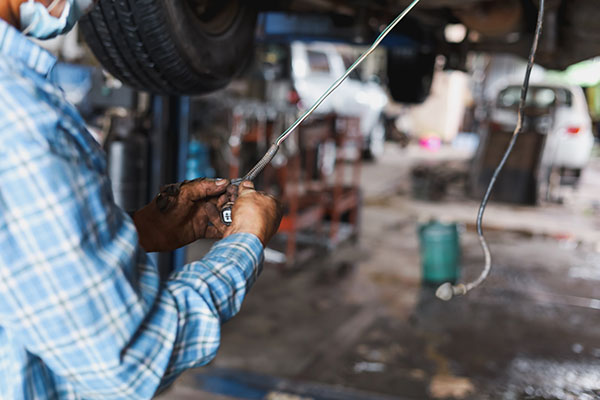 You are here :
Home
> news
> Company News
You are here :
Home
> news
> Company News
Conventional car maintenance covers the following 20 key aspects:
1. Tire pressure inspection:
This is the primary step in car maintenance. It is necessary to carefully check the condition of the wheels and tire pressure, and check whether there are nails or other foreign objects stuck into the inner tube. Once found, the tire should be repaired in a timely manner.
2. Chassis inspection
The chassis is an important component of a car, and it is mainly inspected for oil leakage and loose screws. After long-term driving, vulnerable parts such as rubber sleeves and oil seals under the car may experience oil leakage due to aging, so regular inspections are crucial.
3. Oil and oil filter replacement
The replacement of engine oil and oil filter is usually an essential part of every car maintenance. Automotive engine oil can generally be divided into three categories: mineral engine oil, semi synthetic engine oil, and fully synthetic engine oil, and the replacement cycle of different types of engine oil also varies.
4. Replacement of intake filter screen
As the usage time increases, the intake filter will become clogged due to dust and impurities in the air, thereby affecting its intake efficiency. Therefore, in order to ensure the normal operation of the engine, we need to regularly replace and clean the intake filter.
5. Brake system inspection
As the vehicle is used, the brake fluid in the braking system may gradually decrease, affecting the braking effect. Meanwhile, brake pads and brake discs are also components that are prone to wear and tear. Therefore, during routine maintenance of the vehicle, these key components should be inspected one by one to ensure that they are in good condition. Once any problems are discovered, they should be replaced or repaired immediately to ensure the safety of driving.
6. Antifreeze replacement
Automotive antifreeze, a key liquid that protects the engine in cold winter, not only has antifreeze function, but also can cool down the engine during operation. As the mileage of the vehicle increases, the performance of the antifreeze may gradually decrease. Therefore, it is recommended to replace the antifreeze with a new one every three years or after driving 50000 kilometers to ensure that the engine can run safely and efficiently in winter.

7. Glass water replenishment
Glass water, a necessary item for cleaning car windshields, should be added promptly after use. Especially when using vehicles in winter, it is recommended that car owners choose antifreeze glass water to prevent damage to the glass kettle due to freezing, thus ensuring that the glass water can be used normally.
8. Wiper blade replacement
To ensure clear visibility while driving, it is recommended that car owners check and replace wiper blades every 6 months to 1 year, depending on usage. Once the wiper blades make abnormal noises or fail to clean properly, they should be replaced immediately.
9. Spark plug inspection
According to different materials, automotive spark plugs can generally be divided into nickel alloy (ordinary copper core), platinum spark plugs (platinum), and iridium spark plugs. To ensure stable engine performance, it is recommended that car owners regularly check the wear of spark plugs and replace them as needed.
10. Oil filter
The oil filter is a key component in the maintenance of automotive engines. It can effectively filter out impurities such as dust, carbon deposits, and metal particles in the engine oil, ensuring better protection for the engine. Therefore, regular replacement of the oil filter is essential.
11. Air conditioning filter element
The timing of replacing air conditioning filters usually depends on whether there is any odor inside the vehicle or when the seasons change. In addition, there are no specific replacement standards or frequency requirements.
12. Antifreeze inspection
Although antifreeze can be used for more than 5 years when it leaves the factory, some special situations still need to be noted by car owners. Therefore, during the driving process, the condition of the antifreeze should be observed at all times. Its core function is to prevent winter icing and summer boiling, while suppressing scaling and corrosion phenomena.
13. Brake fluid inspection
Brake fluid has water absorption properties, and with the increase of usage time, oil-water separation may occur. Due to the difference in boiling points, the performance of brake fluid will gradually decrease, thereby affecting the braking effect. Therefore, it is recommended to replace the brake fluid after driving the vehicle for 40000 kilometers. Of course, the specific timing of replacement still depends on the actual situation of the vehicle, but in most cases, following the replacement standard of 40000 kilometers is appropriate.
14. Power steering oil inspection
Power steering fluid, also known as steering assist fluid, is a critical fluid for the power pump of a car's steering system. It enables the steering wheel to easily rotate through hydraulic action, similar to the automatic transmission fluid and brake fluid we previously mentioned. To ensure the smoothness of the steering system, it is recommended to regularly replace the power steering oil.
15. Gasoline filter
A gasoline filter, also known as a gasoline filter, is an important component that ensures clean gasoline supply. According to the mileage provided in the vehicle manual, the owner should replace it regularly. If there are many items that need to be handled during a maintenance, you can choose to replace them later. It is worth noting that most 4S stores or car repair shops hold a conservative attitude towards the mileage of replacing gasoline filters, but in fact, their performance is quite reliable. Therefore, car owners do not need to be too fixated on their suggestions and can handle them flexibly according to the actual situation.
16. Spark plug
Spark plugs are critical components for the normal operation of engines. Once the spark plug fails, the engine will experience unstable operation, vehicle shaking, and even cylinder deformation. Therefore, it is recommended that car owners replace spark plugs in a timely manner after driving 60000 kilometers to ensure stable engine performance.
17. Transmission fluid
For transmission oil, car owners do not need to rush to replace it. For automatic transmission cars, replacement is usually considered when driving around 80000 kilometers; For manual transmission cars, it is recommended to replace them at around 120000 kilometers. The main function of transmission oil is to ensure the smooth operation of the gearbox, thereby extending its service life. After replacement, you will clearly feel that shifting gears is smoother, effectively reducing the vibration, abnormal noise, and gear jumping of the transmission. Once abnormal shifting, vibration, or difficulty shifting is detected, please check the condition of the transmission oil in a timely manner.
18. Brake pads
There is no fixed standard for replacing brake pads, but car owners who frequently use brakes should pay extra attention. When braking, it is essential to carefully inspect the wear of the brake pads to ensure driving safety.
19. Battery
The replacement cycle of car batteries is usually about 40000 kilometers. If the vehicle has not been used for a long time and there is a feeling of insufficient power when restarted, it may indicate battery loss. In addition, after the vehicle is turned off, it should be avoided to turn on the headlights or in car entertainment system for a long time to avoid excessive depletion of battery power.
20. Tire replacement
When replacing tires, we usually consider several factors, including the noise reduction effect of the tire, the degree of wear, and personal needs. However, apart from wear and tear replacement, other factors are often determined based on the individual situation of the car owner and there are no mandatory regulations. Therefore, when discussing tire replacement, we mainly focus on the aspect of wear replacement. There is a viewpoint that suggests replacing tires should be considered when they have been used for more than 6 years or have been driven for over 60000 kilometers. However, it is worth noting that if the vehicle is not driven frequently or the tire wear is not obvious, there may be no need to rush for replacement. The durability of tires is quite excellent, and they are not as fragile as people imagine. It is also possible to delay replacement appropriately.
 Website
Website



